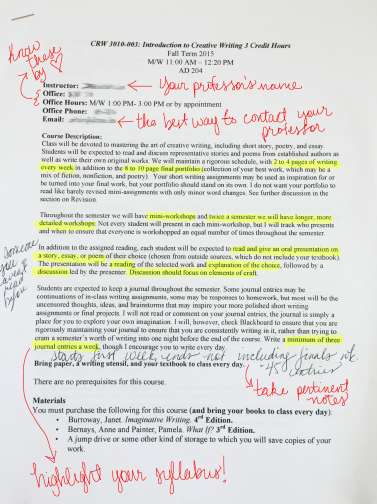
Did anyone else feel like the first week of classes felt like an entire semester crammed into five days? I’m so glad I was able to spend the weekend with friends, because if I hadn’t been able to, I just might have gone stir crazy. But with the first week of classes came my favorite time of any semester: syllabi planning.

Typically, the first meeting of any class will be mostly a discussion of the syllabus, possibly with some work thrown in there if time permits. This year, I’m using my Erin Condren Life Planner to organize everything, along with a combination of Sharpie pens and Staedtler pens. I broke everything out into colors and assigned each class its own pen. I keep the key on my page marker (as seen above) so that it’s always on the current week in case I need to refer to it. (Shout out to my internship at Deep South Magazine! Click here to read what I’ve written.)

I always try to print syllabi before classes meet so that I can read through them, highlight important dates or details, and make any necessary notes. While in class, if the professor stresses something that’s in the syllabus, I highlight or underline it, and if the professor says something that’s not included in the syllabus but sounds like it could affect my success in the class, I’ll jot a quick note down.
I learned quickly that memorizing a professor’s email address, office hours, and office number is one of the best things I could do as a student. I love office hours because I can sit with the professor and talk one-on-one about issues I’m having in class, with an assignment, or with a deadline. Plus, for the sample syllabus I have pictured, the professor’s office is so fun. She has three bookshelves, stocked up with books on the craft of writing. It’s basically my dream office.

The best part of any syllabus is the semester schedule, and if your professor doesn’t provide one, you might want to ask him or her to see if there’s one available. The above schedule lists what will be discussed in class on any given day and what will be assigned as homework for the next class. (By the way, if no one has told you yet, homework is still important in college. It may not be mandatory, but it’s a good idea to do it anyway so you have a better understanding of the material.) These are the dates and the correlating information that I use when assembling my weekly layouts.

At the end of each day or during long breaks between classes, I sat at my desk, fanned out the syllabi received that day, and got to work filling in my planner. This picture is from this week (because the first week’s spread ended up looking so unphotogenic), so you can see a breakdown of my assignments, discussion points, etc. It’s organized somewhat differently for each class. For example, my Creative Writing class (pink) has homework due Wednesday listed under Monday. My Anthropology class (burgundy), on the other hand, has that day’s discussion points and readings listed (see Tuesday and Thursday). The way you structure your week will depend on each syllabus and how you think your brain will process the information best. I also have two other sections per day dedicated to personal errands and work. Those won’t look so desolate once school events pick up and I get my work schedule sorted out.
One of, if not my biggest, coping mechanism is to organize everything. I have my planner, I have sticky notes adhered to the base of my iMac, and I have running checklists for each day. Taking these steps keeps everything in order in my mind so that I actually follow through on things I’ve committed to, and a huge part of this process is marking information found in syllabi in my planner. Otherwise, I’d probably find myself neck-deep in deadlines and missed readings, and I already have a fear of drowning; let’s not add drowning in schoolwork to that.
Your takeaways:
- Color-coding is your best friend
- Print syllabi in advance if possible; if not, transcribe the information ASAP after you receive your syllabi
- Memorize your professor’s email, office hours, and office number (but don’t stalk him or her—that’s a given)
- Highlight and take notes on syllabi before and while the professors speak about them in your classes
- Organize your planner (or however you choose to keep all of this information together) in the way that’s best for you—do you need to list all the things due on a particular day, or do you need to write in what’s due for the next class?
Good luck, my friends. Now that the first week’s over, the fun is just beginning.
In the meantime, I’m curious to know: how do you structure your coursework?
I’ll see you right back here next Monday morning!




